Science Artworks for a good Cause
Ten artworks from science, selected by AI+Art Curator Adrian Notz, were auctioned at Kunsthaus Zurich, celebrating the 10 year anniversary of headcount AG. All the proceeds of which will be donated to support ETH Foundation scholarships.
Headcount AG is a Zürich based recruitment consultancy specialized in the Healthcare and Life Science sectors. On the occasion of the consultancy's 10th anniversary, it launched, in collaboration with the ETH Foundation and the ETH AI Center's AI+Art Curator Adrian Notz, an auction of ten “artworks for a good cause”. All ten “artworks”, carefully selected and curatred by Adrian Notz from a manifold of proposals, were auctioned at Kunsthaus Zurich on 30th November 2022, all the proceeds of which were donated to support ETH Foundation scholarships. The lucky buyers, all from the life science field, enthusiastically bid along, while the artists formerly known as scientists were delighted to see their research work produced as artwork.
Rachel Sava, who is not only one of the scientist-artists but also a recipient of Excellence scholarships, gave a powerful inspiring speech.
It was impressive to see the future-shaping effect of the scholarships. We are very pleased to be able to make a contribution to this cause.
These are the selected artworks:
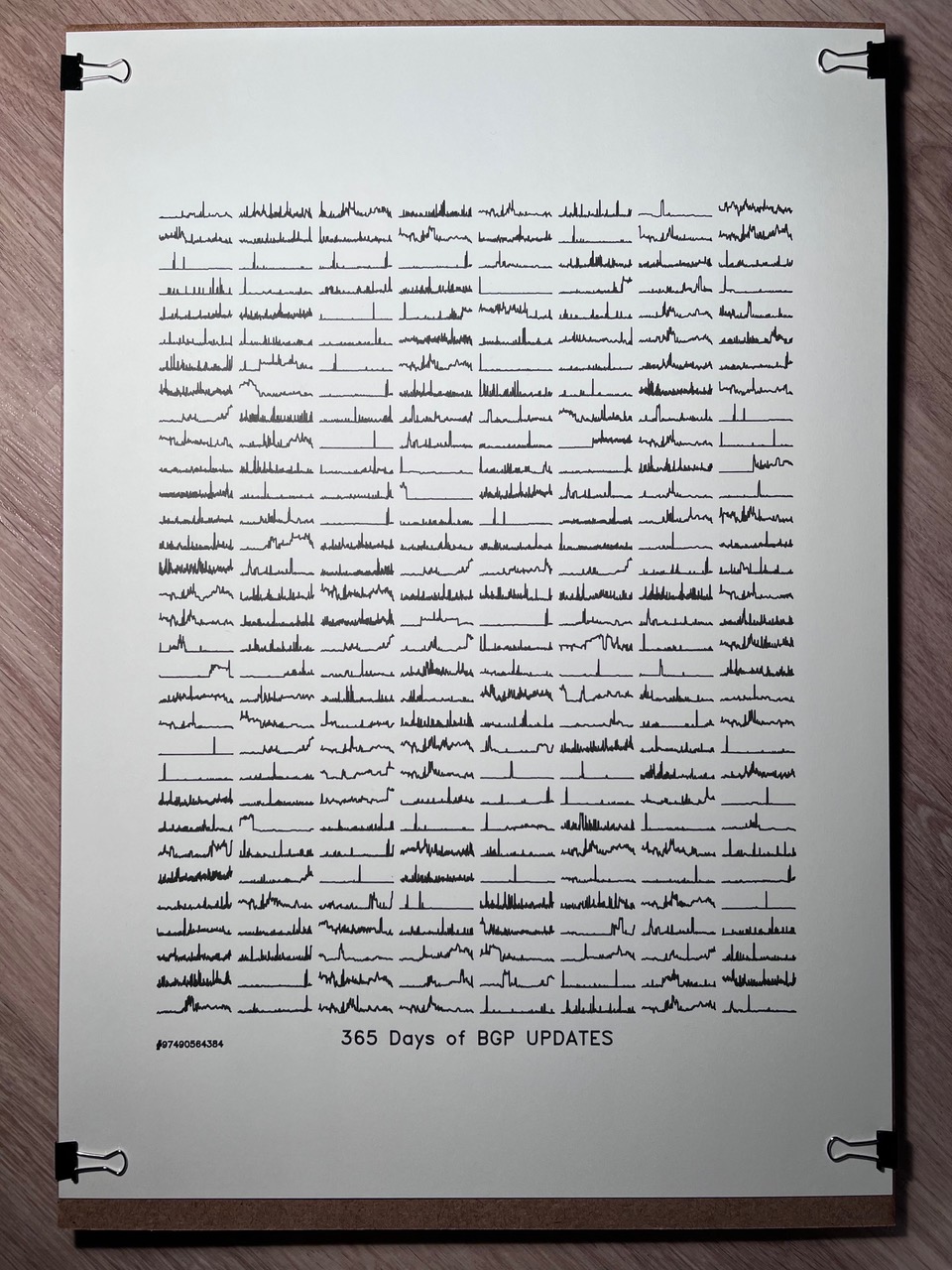
Laurent Vanbever, ECG of the Internet, 2022
Eight years ago, artist Kenneth Goldsmith made an artwork, “Printing out the Internet”, where he asked people to send him printed-out pages of the internet, fast filling the room of a gallery space. In the second year of the Covid-19 pandemic, when a major part of our activities had already more permanently moved online into the internet, Laurent Vanbever, made a drawing of the “ECG of the Internet”. For this he measured the Border Gateway Protocol, BGP, announcements of 256 internet routers. In practice, the Internet is composed of literally millions of internet router vantage points. This work is based on publicly available data. Even though the drawing was composed from a small subset of all internet routers, there were still over 97 billion announcements, which can be considered to be the creators of this work. Vanbever started the work in order to show a different illustration of the infrastructure of the internet, which is mostly composed in a geographical way. He chose a time-based approach. It also reminds us not just of the pulse of the internet, but also of a record of seismographic measurements or even a polygraph.
Prof. Laurent Vanbever is an associate professor at the Networked Systems Group (NSG) in the Department of Information Technology and Electrical Engineering (D-ITET) at ETH Zurich.
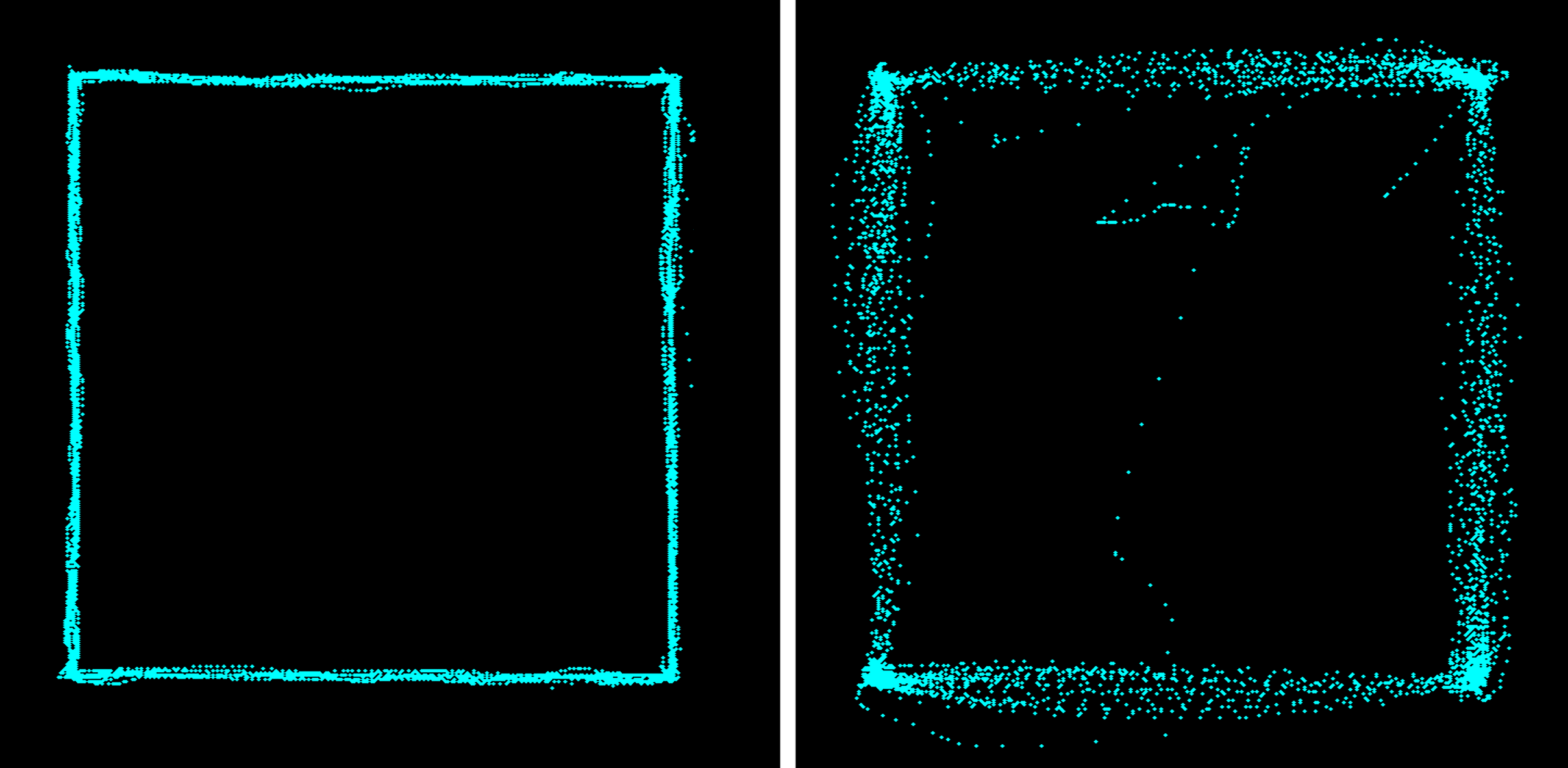
Tobias Kowatsch, Fabian Wahle & Andreas Filler, Black Square (stressed out), 2022
In 1915, Russian artist Kazimir Malevich presented his work Black Square for the first time in history in The Last Futurist Exhibition 0.10, St Petersburg. Hung in the room’s “icon corner”, a small worship space typical of many Catholic and Orthodox Christian homes, it is generally understood not only as the “zero degree” of painting but also as an “Icon of Modernity”. In the context of the time, when technology was advancing at exponential speed similar to that of today and revolutions of the working class were arising, the black square was a symbol for "the supremacy of pure artistic feeling", as opposed to the visual depiction of objects, presenting a new horizon that went far beyond the status quo. These two mouse pad black squares by Tobias Kowatsch and his research group show us, over a century later, what a stressful effect this new horizon, where we all need to be creative artists to work better, has on us. It seems as if Malevich, a strong icon of modernity, has started to tremble due to the increase of labor since then.
Dr. Tobias Kowatsch is Associate Professor for Digital Health Interventions at the external page Institute for Implementation Science in Health Care, University of Zurich (UZH), and Director at the School of Medicine, University of St.Gallen (HSG). He is also the Scientific Director of the external page Centre for Digital Health Interventions, a joint initiative of UZH, HSG, and ETH Zurich.
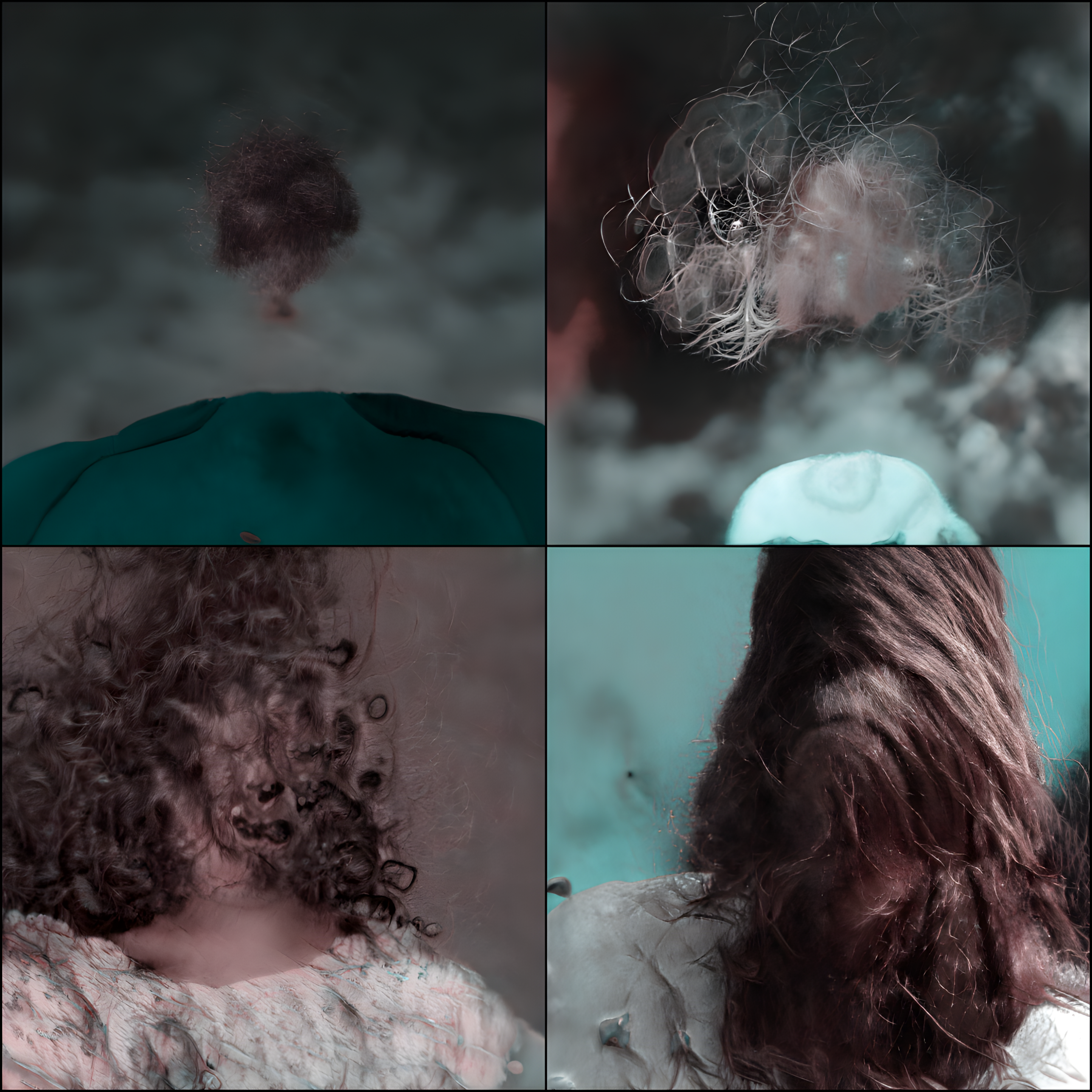
Evan Ntavelis, Unfamiliar Faces, 2022
Unfamiliar Faces by Evan Ntavelis presents us with an uncanny machine hallucination out of a latent space that is beyond our understanding and control. The work consists of a series of four framed photo prints. The hairy monstrous creatures give a hint that the AI system has been trained with images of dogs and cats and faces of humans. It not only shows us the Uncanny - “das Unheimliche”, in German - of what machines might hallucinate, but also reminds us of 18th-century philosophers’ enquiries into the origin of our ideas of the Sublime and Beautiful that have this horrific shiver to them. Dadaist and Surrealist Max Ernst explored the Sublime in his 1934 work Une semaine de bonté by cutting out illustrations from 19th-century horror novels. Ntavelis’ work evokes this same kind of sublime aesthetic pleasure of the Uncanny.
Evan Ntavelis is a PhD Student at the Computer Vision Lab in the Department of Computer Science (D-INFK) at ETH Zurich.

Giorgia Greter, Mouse Gut Bacteria, 2022
The shift between micro- and macroscopic perspectives has fascinated us since the moment technology allowed us to see into these various dimensions. The main fascination here is the prospect of viewing the same structures on the infinitesimally small or infinitely large scale, potentially implying that our universe is itself a micro- within a macrocosm. That we see here something as vulgar and unattractive as bacteria in a mouse gut displayed with such celestial beauty reminds us of the beauty in the primordial cosmic creation of reality as we live it. This image is a powerful chaotic capture that reminds us of the philosophical idea of immanence - understanding the divine not as something beyond our own reality but as a part of it.
Giorgia Greter is a PhD student at the Laboratory for Mucosal Immunology in the Department of Health Sciences and Technology (D-HEST) at ETH Zurich

Loren Ban, Ruth Signorell & Francesca van Swaaij, Laser Aerosols, 2022
This image shows how laser light is scattered from small aerosol particles when characterizing the physical properties of these particles, which are of great importance for life science, in particular human health. With the Covid pandemic aerosol particles came into the spotlight as they are responsible for viral transmission through afflicted individuals’ coughing and sneezing and subsequent inhalation into other individuals’ respiratory systems. While our breath became a deadly viral threat, we were simultaneously encouraged to breathe in and breathe out, to meditate and become conscious, to live in the now in order to lower our anxiety and stress levels. With the Greek word pneuma meaning “breath” and “breathing” as well as “spirit” and “soul”, this ambivalence is captured very well. In this combined sense of breath and spirit, pneuma means the force of life. The scattered laser light from aerosol particles tells us whether the pneumatic force is one of stress relief or virus - of life or death. Understanding the physical properties of the tiny aerosol particles helps us understand how we are connected to our biosphere and planet. They make us more than human, “posthuman”, as artists would say nowadays, referring to biologists like Lynn Margulis, scientist Donna Haraway or philosopher Bruno Latour, truly terrestrial creatures.
Dr. Loren Ban is a Post-Doctoral researcher and Francesca van Swaaij a student un the Aerosols and NanoscienceGroup led by Prof. Dr. Ruth Signorell in the Department of Chemisty and Applied Biosciences at ETH Zurich.

Niko Beerenwinkel & Robert Noble, Evolving Tumor, 2022
Diagrams and curves, especially fast growing and exponential ones, have become ubiquitous in the last two years. Diagrams have also always been a part of avant garde artistic practice, though, well exemplified by Dada artist Francis Picabia and his machine drawings as well as Fluxus artist George Maciunas and his diagrams trying to explain Fluxus and other contemporary art movements. While Picabia stated that “the genius of the modern world is in machinery” and saw the machine as the very soul of human life, he never got to let a machine do the drawing. In this work, Evolving Tumor by the ETHZ Computational Biology Group, the machine has done the drawing, depicting nature - specifically, a tumor. The colorful flow of pastel bands of dividing, migrating and growing cells are more reminiscent of a spring riverbed than of the mutating genotypes of a tumor.
Prof. Dr. Niko Beerenwinkel is Full Professor of Computational Biology at the Department of Biosystems Science and Engineering (D-BSSE) of ETH Zurich in Basel.

Rachel Sava, Embodied Neural Networks, 2022
Neural networks in Machine Learning are currently the cutting-edge reference for Artificial Intelligence research and development. In close collaboration and connection with Neuroscience and Cognitive Science, we are trying to copy the high complexity of our own neural networks to achieve deep learning for the machines. Success: The deep learning neural network has become so self-generating that researchers are currently catching up in trying to understand what is happening in this “black box”. During her time in the ETHZ Bio Engineering Laboratory, BEL, Rachel Sava had the possibility to peep into the black box of these biological networks of neurons in murines, i.e. mice. In a strange artistic inversion, she selected interesting cells and subnetworks to incorporate into this mind map. Her drawings appear to be in ink or even aquarelle but are in fact digital vector drawings. The intelligence of her hand translates the biological neural networks back into the digital, thus making them artificial and artistic neural networks. Sava names the drawings “mind maps”. They are a stunning impression of how our mind and the minds of other living beings with a brain are not just in the head but the whole body, in every cell of our tissues. Our intelligence is embodied and concrete, while the intelligence of an AI is still very virtual.
Rachel Sava Biotechnology MSc student at the external page Institute of Neuroninformatics at the ETH Zürich and UZH.
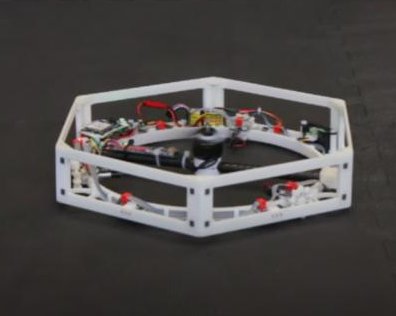
Raffaello D'Andrea, Distributed Flight Array Singularity, 2022
The Distributed Flight Array can only fly when its single parts are joined together as an ensemble - a group or collective. One individual vehicle exhibits erratic, uncontrolled, random and chaotic flight - a “singularity dance”, according to the laws of chance. This can be seen as a very concrete metaphor of how our society of individual singularities has chaos in it, but our social structure, sometimes also our conformity, makes humans productive, allowing us to fly off the ground in a stable manner. A century ago, artist Hans Arp discovered a method for his collages, which he called “Selon les lois de Hasard”- “According to the laws of Chance”. He said it is the law that holds nature together in its innermost. Considering the concept of quantum randomness, we can say that he was right. Randomness became an artistic means, heavily explored in action painting and kinetic art. The chaotic Distributed Flight Array Singularity has this artistic method of randomness in itself and goes beyond the idea of a genius author creating an artwork, which was also the vision of artists working with randomness. We can paraphrase philosopher Friedrich Nietzsche when observing the dance of the Distributed Flight Array Singularity: “One must still have chaos in oneself to be able to give birth to a dancing star.”
Prof. Dr. Raffaello D'Andrea is professor at the Institute for Dynamic Systems and Control in the Department of Mechanical and Process Engineering (D-MAVT) at the ETH Zurich.

Timm Schroeder & Leo Kunz, In Advance of the Broken Femur, 2022
In 1964, French artist Marcel Duchamp selected a snow shovel and named it “In Advance of the Broken Arm”. This practice he had pioneered half a century earlier and called it Readymade. Duchamp's idea was that the artistic work can be reduced by simply selecting a ready-made new object, declaring it to be art and presenting it as such. With “In Advance of the Broken Arm” he implied that without the snow shovel clearing the path of snow, one might slip and break an arm. Later contemporary artists referring to this work have shared x-ray images of their own broken legs or arms. Timm Schroeder’s mouse femur research presents a different approach to preventing a broken leg or arm by showing cells, nerves, blood, fat and vessels produced in bones. Understanding this better in mice may ultimately help a lot of broken human limbs heal better.
Prof. Dr. Timm Schroeder is professor at the Cell Systems Dynamics Group in the Department of Biosystems Sience and Engineering at the ETH Zurich.
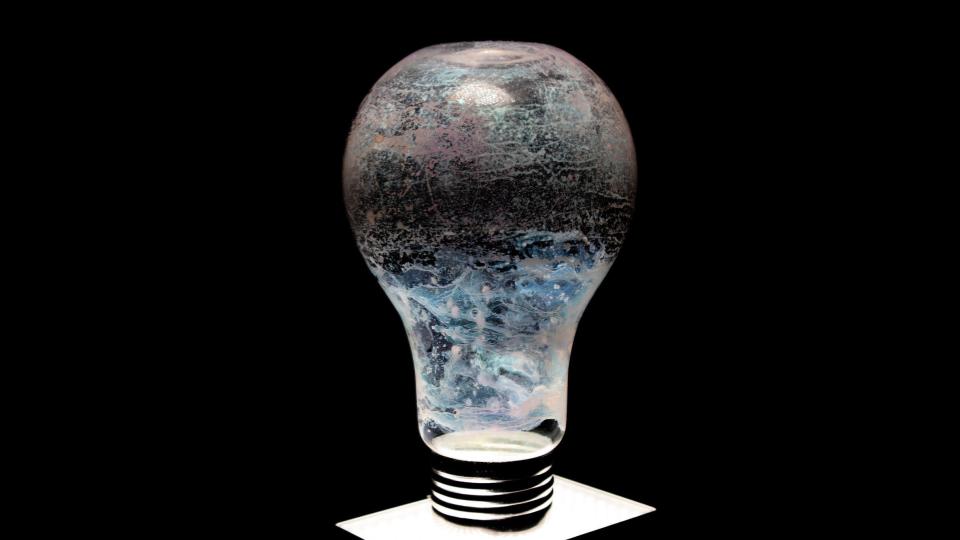
Alexander Jessernig, Structural Colors Bulb, 2022
Inspired by the manifold of animals found in nature that use the phenomenon of iridescent coloration for camouflage or to gain a mating advantage over competitors, Alexander Jesserni and his collaborators created structurally crafted highly monodisperse polystyrene latex particles with a size of ca. 270 nm. Through a vertical deposition method these beads form highly ordered arrays on the glass surface that interact with light at the corresponding wavelength and lead to a beautiful green shimmer. This happens by the physical interaction of visible light with the crafted nanostructures. The structural colors are applied to a bulb shaped vase that then carries these kaleidoscopic and iridescent features.
Sculptor Constantin Brancusi sometimes stayed for a couple of days during the whole day in his studio to wait until the daylight fell perfectly on his “Golden Bird” sculpture to take a photo. These photos completed his sculptural artistic works. With the Structural Colors Bulb constantly changing in the light and making us aware of these changes in time, Brancusi’s vision is combined in an object which we might call a new form of “photo sculpture”. This fragile ephemerality of the work is also structurally incorporated in the object; if the vessel is washed or filled with water the structural color will fade away.
Alexander Jessernig is a PhD researcher at the Nanopartilces Systems Engineering Laboratory led by Prof. Dr. Inge Herrmann in the Department of Mechanical and Process Engineering at the ETH Zurich.